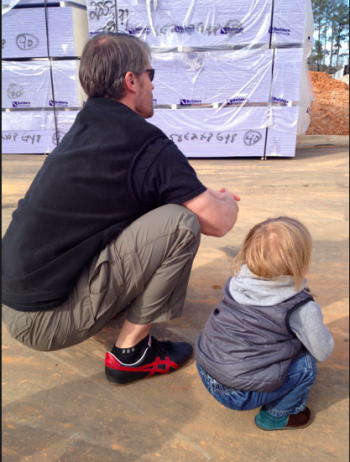Got Original Squat?
Oct 15, 2014
[caption id="attachment_2176" align="alignleft" width="273"] My son squatting at 23 months old[/caption]
My son squatting at 23 months old[/caption]
Some exercisers and fitness people hate to squat. I used to be one of them.
Then I heard how beneficial it was to building a big, strong, muscular body, then I embraced them until my knees rebelled. Apparently I wasn’t really squatting. I was doing some form of a deadlift combined with a good morning which is often called a “power squat.”
To fix my knees and force my legs and body into growing bigger and stronger through submission, I looked at Olympic lifters legs and taught myself how to squat all the way down - butt-to-ankles. That, my knees liked. My legs immediately grew, especially when I increased the frequency of my squatting. This was back in 1994/95 when squatting all the way down was supposed to make your knees explode, and deform your yet-to-be-born children.
Since I worked in the gym and I had keys to it, I’d go in when it was closed and take out the pins in the squat rack and squat as heavy as I could, again, butt-to-ankles, tempting the fitness powers that be to strike my knees with catastrophic injury.
And you know what?
That injury never came. In fact, my legs only got stronger and bigger. Bigger and stronger.
Some other funny things happened too:
The rest of my body got stronger.
I got leaner.
And my stamina/wind/conditioning/cardio improved without working on it specifically.
And this was a time when you had to do cardio, especially if you wanted to lose fat. Had. To. Yet, I was proving the “fitness gods” wrong.
In fact, one time, I separated my left shoulder when a woman kicked open her car door catching my bike pedal, and I flipped butt over handlebars. I couldn’t do any upper body work for a whole month so all I did was two lower body exercises three days a week, the first being the squat.
The results?
No loss in my upper body strength, without doing any upper body work for a whole month.
If I was getting so many amazing results from this one exercise, it begs a question:
Why do people hate this innocent little exercise?
Because it’s hard. And uncomfortable. And we’re no good at it. At least not when we get older.
However, when we were younger… Ahhh… Yes… We “loved” to squat! Too bad we don’t remember that.
It’s true.
The squat isn’t just an exercise that people love to hate, it’s a fundamental movement pattern that we’re born with and designed to do, and keep, for our entire lives. My son started squatting somewhere between 12 and 15 months of age and literally squatted all the time for everything that was even remotely interesting below eye level for close to a year. In fact, he still squats. And it’s natural and easy for him.
It should remain so for us too.
So what happened?
How did so many of us lose our squat - this fundamental movement pattern?
Well let me just say that not all of us have. (Us = the entire human race.)
There are places in Asia where people squat all the time - it’s their main resting position and in many of these same cultures, it’s the elimination position of choice. They squat over a hole in the ground. (Need I be more graphic? I think not.)
Back to how some of us lost our squat…
Sitting.
In chairs.
Too much.
Think about this: The average American sits for 13 hours a day.(1) That’s over half a day, each day, every day.
Why is sitting so bad?
Because sitting in a chair changes the function of your body. Sitting in a chair is essentially returning to the womb state where your postural muscles, strengthened by your postural reflexes that you gained while growing through the neuro-developmental sequence from birth to about 3 years of age, are weakened. This includes your core musculature - your abs and pelvic floor. As a result, muscles get short and tight and we lose our reflexive stability - our ability to subconsciously anticipate, prepare and use the right joints and muscles involved in movement for that movement.
With posture change and the “dulling” of our postural reflexes come all sorts of other unwanted effects: Musculo-skeletal overuse injuries, decreased immune system function, decreased digestive system function, decreased cognitive function including attention span, and diseases such as diabetes, cancer, obesity, and cardiovascular disease.
In fact, several recent studies concluded that too much time spent sitting actually kills you faster.(2)
So how then do you regain this squat you once had? And how does it once again become “normal” and even “easy” to squat?
Rocking is a great start. In fact, it might be the best start.
Here’s a video of Tim explaining how to rock to recapture your squat.
Remember, you’re designed to move well and move often and squatting is part of that movement.
Get Squat.
References:
(1) https://www.prnewswire.com/news-releases/new-survey-to-sit-or-stand-almost-70-of-full-time-american-workers-hate-sitting-but-they-do-it-all-day-every-day-215804771.html
(2) https://well.blogs.nytimes.com/2012/10/17/get-up-get-out-dont-sit/?_php=true&_type=blogs&_r=0
Comments (0)
Please login to comment.